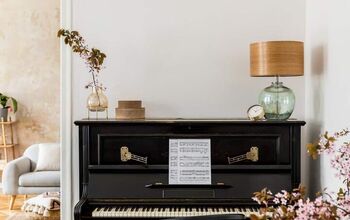How To Choose The Perfect Colors For Your Home

Your home should be a place you can’t wait to return to after a busy day at work or a long vacation. Hopefully, you feel at peace when you walk through your front door. However, if the colors in your house don't feel right, it can throw off how you feel.
Let how you want to feel in your home and the colors you love guide you when choosing house colors. If you enjoy changing things up often, pick trending colors. If you prefer not to paint frequently, opt for timeless hues. Always test samples before committing to a color and observe the colors under different lighting and situations.
Even if you’ve never thought much about the colors in your house, they still play a vital role in how you feel. If you’re moving into a new place or renovating, choosing the perfect colors for your home should be one of your top priorities.
Why Is Choosing The Right Colors For Your Home Important?
Many discussions and studies look at the idea of colors affecting mood. The idea that different colors make you feel certain ways has been around for a long time. For example, warm, bright colors like reds, oranges, and yellows tend to energize, while soft shades of blue or green can help you relax.
It’s also believed that various colors have different effects on your body. For example, red is thought to stimulate your appetite. (There’s a reason so many fast-food restaurants include red in their logos and signs.)
Therefore, assorted shades of red are often seen in dining rooms. But what if you can’t stand the color red? Do you really want it on any of the walls in your house? Probably not.
No matter what your stance is on color psychology, you likely have colors that you gravitate toward and others you despise. If you pick a popular shade of green for your walls because it’s in style, but you hate green, then it’s not a good choice for you. You’ll end up with negative reactions and feelings whenever you walk into the room.
Choosing the right colors is important to make your home a place you love. Otherwise, you’ll feel out of sorts, regretful about your color choices, and always sense that something isn’t quite right.
Where Do You Start When Selecting House Colors?
Now that you understand why finding the right colors for your home is important, how do you pick them? There are thousands of colors out there, and each has a bunch of different variations. You’ll find plenty of tints, tones, and shades of every color.
- Shade -- You get a shade of a color by adding black to it.
- Tint -- You get a tint of a color by adding white to it.
- Tone -- You get a tone of a color by adding gray to it.
Here are a few things to consider to help narrow down your options.
What Colors Are Trending?
If you like keeping up with the latest design trends, scroll through Pinterest or your favorite design mag to see what colors are trending. Note, that we said trending, not trendy.
Trendy tends to mean something that’s in for the moment and will likely be out in a few months, making way for the next fad. Trendy is great for things that are quick and easy to change, like throw pillows and vases.
However, if a color is trending, it means it’s been popular for a while now. It just happens to be having a spotlight moment in the design world.
How Often Do You Like To Paint?
Consider how often you enjoy changing up the look of your home and if you like to paint. If you do, selecting trending colors or even trendy ones might be fine. If you have no problem painting again in 6 months or a year, go for it.
But if you would prefer to paint sparingly, select more timeless colors. Neutrals are a good pick if you love to change your decor often, but hate to paint. You get a nice, blank canvas that goes with anything. Therefore, whether you want hot pink pillows or crisp white ones, you can make it work.
How Do You Want A Room To Make You Feel?
The next thing to consider when selecting colors for your home is how you want to feel in a space. Revisit what we said earlier about colors affecting your mood. If you want to feel relaxed and calm, choose softer, more subdued colors.
If you’re painting the home gym, you’ll likely want more energizing colors. Research various options and look at them for a few minutes to determine your reaction to them.
The Reasons You Shouldn’t Choose A Specific Color For Your House
When considering all the reasons you should pick colors for your home, it’s worth noting why you shouldn’t choose a color.
- Don’t pick a color because it’s the Pantone Color of the Year (unless you happen to love it).
- Avoid making a decision based on other people’s choices. If you love the color in your best friend’s house, you still need to test it. (It might not look the same in your home.)
- Don’t pick your colors based on what paint is on sale the day you go to the paint store.
- Your mother-in-law gave you her leftover cans of paint from her recent renovation. Not a good reason.
Tips For Finding The Perfect Colors For Your Home
Once you know the general ballpark of colors you want to use in your home, it’s time to get the precise hues. You likely only want to paint once (until you’re ready to change things up again in a few years or ten). Therefore, take your time to select the perfect colors for your house.
Narrow Down Your Options
It’s fine to use the little paper paint swatches in the store to narrow down your options from 20 to five or so. But that’s it. This is where the little strips of colorful paper should stop. Now, it’s time to test out your choices with the real deal.
Purchase Paint Samples
Get paint samples of each of the colors you’re considering, between three and five is a good number. Typically, stores offer samples in flat or satin finishes. Select the finish that is as close as possible to the one you’ll be using in your space.
Create Your Own Color Swatches
Buy some white poster boards and paint them with your sample paint. This step gives you large test swatches that you can move around the space. Plus, larger samples make it easier to assess a color instead of a little three-inch brush stroke on the wall.
Look At The Color In Different Situations
The poster board trick enables you to move the samples around the room to see the color in different spots. Test out the color by the window, across from it, during the daytime, and at night. See how the lighting in the room affects the color and try out different bulbs.
Different light colors influence your mood and how colors look, making some hues brighter and others darker. The testing process is all about finding the right mix of color and lighting to create the perfect space for you.
Be Thoughtful About Color Combinations
As you decide on the colors you’d like to use in your home, test out various shades, tones, and tints. Using a color wheel can help you determine what colors go together and also provide you with a glimpse at different variations of hues.
Select colors next to each other on the color wheel if you want to color-drench a space for a calmer vibe. Choose colors opposite of each other for a more dramatic finish.
Color Your Home With Hues You Love
Ultimately, the colors in your home should reflect your personality style, and how you want to feel. If you love them and they make you happy, then they’re the right colors for your space. Narrow down your options to a few favorites, then use samples to test and experiment until you find the winners.
By all means, get inspiration from others, design experts, Pinterest, and yes, even HGTV. However, when it’s time to put the paint on the walls, go with your gut, and choose what you love.
Related Guides:
- What Color To Paint The Stair Railing? (We Have The Answer!)
- What Paint Color Goes With Light Blue Carpet? (Find Out Now!)
- What Curtain Colors Go With Cream Walls?

Stacy Randall is a wife, mother, and freelance writer from NOLA that has always had a love for DIY projects, home organization, and making spaces beautiful. Together with her husband, she has been spending the last several years lovingly renovating her grandparent's former home, making it their own and learning a lot about life along the way.
More by Stacy Randall

























![Standard Dining Room Table Dimensions [for 4, 6, 8, 10 and 12 People]](https://cdn-fastly.upgradedhome.com/media/2023/07/31/9074335/standard-dining-room-table-dimensions-for-4-6-8-10-and-12-people.jpg?size=350x220)

